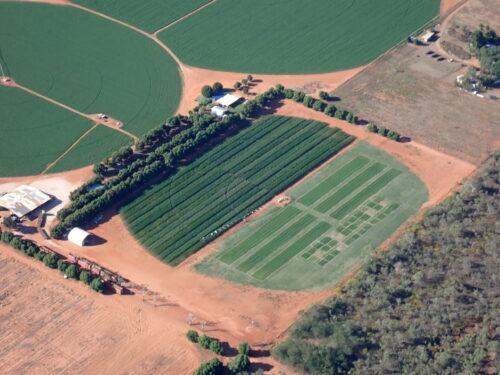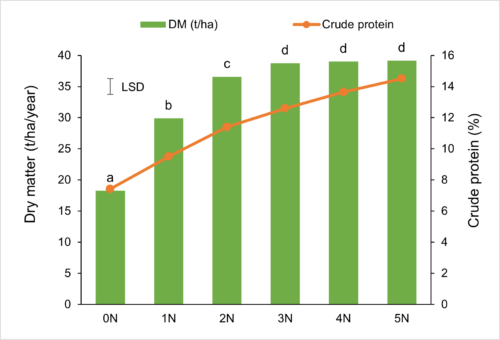Localised, small-scale developments of groundwater assets across the Kimberley and Pilbara regions are creating opportunities to increase the productivity of the northern beef industry. The Department of Primary Industries and Regional Development (DPIRD) is researching irrigated forage production in the northern rangelands of WA.
Fodder research yields big opportunity for small-scale irrigation in northern WA
Growing your own fodder
Pastoralists have an opportunity to grow their own fodder on-station where small-scale irrigation developments are possible. This could involve directly grazing centre-pivots to finish cattle, or producing hay or silage to feed out when required. Having a supply of local fodder offers pastoralists increased options and can support business flexibility and resilience. Since 2020, research trials have been conducted on a commercial property at Skuthorpe on the outskirts of Broome. The farm uses centre-pivot irrigation to produce silage and hay—primarily from Rhodes grass.
To date, the research trials have:
- quantified seasonal production and feed quality profiles for a range of tropical and subtropical forages,
- developed locally relevant best-management guidelines including for fall armyworm,
- developed nitrogen response curves for perennial grasses, estimated nitrogen use efficiency and monitored nutrient leaching.

What are the best perennial fodder options?
A wide range of fodder plants have been tested in the northwest over the years, by the department and industry alike. With irrigation, there are actually many temperate, subtropical and tropical plants that grow in the northwest. The real question is: what grows high biomass consistently throughout the year?
To answer this, DPIRD planted a perennial grass variety trial to compare and contrast 12 popular options. All of the grasses were tropical or subtropical species, after previous trial work near Broome showed that temperate species struggle to cope with the hot, humid wet season conditions, and cannot compete in terms of dry matter yield (Mosaic Ag Bulletin).
Data collected from this trial and others supports the theory that as dry matter yield increases, feed quality decreases. This is due to an increasing proportion of stem in the sward compared to leaf, which is more fibrous and therefore less digestible.
Short grazing rotations or cutting cycles encourage greater leaf growth, rather than stem elongation. However, the longer the stand grows, the higher the biomass (even if a higher proportion of the sward is stem). This means that hay and silage operations that aim to maximise biomass are likely to have a longer growth interval between cuts (approx. 28 days on average), while operations that graze cattle directly on the irrigated pasture are likely to have a shorter grazing interval to maximise pasture utilisation (14-21 days on average).
DPIRD’s perennial grass trials were sampled every 28 days and then mown and baled to ‘reset’ them using commercial hay machinery. Data were collected from 23 cuts over a two-year period.
Results – Rhodes grass and panic grass lead the field
Rhodes grass (Chloris gayana) under irrigation is highly productive and relatively resilient to seasonal variation. When cut every 28 days, as in a commercial hay operation, dry matter yields of up to 35-40 t/ha annually are an achievable benchmark.
This means that Rhodes grass has an average daily growth rate of over 100 kg/ha/day dry matter. In reality, the daily growth rates change with the seasons, varying from 50kg/ha/day to 200kg/ha/day. The main factor driving this variation is the minimum nighttime temperatures experienced in the dry season that slow the growth rate.
In the warm and humid wet season months, panic grass (Megathyrsus maximus) stood out as a highly productive alternative to Rhodes. The data also showed that panic grass can offer a higher nutritive value than Rhodes grass due to its better digestibility and palatability, making it a great candidate for direct grazing systems. It still performs comparably with Rhodes grass in the dry season, but is more sensitive to cool temperatures and tends to shut down more.
While there wasn’t much difference between varieties of Rhodes grass and panic grasses, the very best performers were Reclaimer Rhodes, Callide Rhodes, Megamax panic and Gatton panic. Other species trialled like Jarra grass (Digitaria milanjiana), Humidicola (Brachiaria humidicola) and Splenda setaria (Setaria splendida) were too tropical for the Broome climate, as they ceased growing in the dry season.
The impact of fertiliser
To maintain this level of dry matter production, fertiliser inputs are required. DPIRD conducted a nitrogen rate trial to generate a response curve to inform nitrogen decision making. The form of nitrogen fertiliser tested in this trial was granular urea, though other nitrogen fertilisers are currently being investigated. Lysimeters buried in the ground beneath the plots trap leached water and nutrients for analysis.
Moderate nitrogen rates of 2-3 kg N/ha/day achieve 35-40 t/ha dry matter and applying more than this does not produce more biomass (Figure 1). At these rates, crude protein is around 12%, which is adequate for liveweight gain, but as more N is applied, protein levels do increase (Figure 1).

What about irrigated annual crops?
Metabolisable energy has a ceiling in perennial C4 grasses. Growing annual crops like maize and sorghum can offer higher metabolisable energy per unit of dry matter to achieve faster weight gains in cattle (Table 1). For example, adding maize grain to a ration can enable liveweight gains not achievable from feeding perennial grass fodders alone (e.g. liveweight gains of 1 kg/ha/day).
However, annual cropping systems require greater management capacity and capital investment (machinery and inputs) compared to perennial grasses. They are more sensitive to water stress, nutrient deficiencies, and insect pests. Getting the timing right for watering and fertiliser is critical.
Table 1. Relative yields and indicative feed quality of different fodder crops*
| Fodder crop | Expected DM yield (tonnes/hectare/year) | Crude protein (%) | Metabolisable energy (MJ/kg dry matter) |
|---|---|---|---|
| Rhodes grass (Reclaimer) | 35-42 | 12-16 | 7.5-9 |
| Panic grass (Megamax 059) | 35-40 | 14-18 | 8.5-9.5 |
| Forage maize (including grain) | 20-30 | 9-11 | 9.5-11.5 |
| Hybrid sorghum | 25-50 | 12-14 | 8-9.5 |
| Maize grain | 10-15 | 10-12 | 13-14 |
For more information
Download for free Bulletin 4915, ‘Mosaic Agriculture: A guide to irrigated crop and forage production in northern WA’.
Alternatively, contact Carla Milazzo, Development Officer on 0436 826 970, or